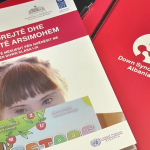Special Education in Albania has its own history of development. The institutionalized treatment of children with disabilities began as early as 1963 with the establishment of the Institute for Blind and Deaf Students. Later on, after 1970s in the cities where there were psychiatric hospitals, the first schools for students with mild mental retardation were opened. It should be emphasized that the state policy of treating children with disabilities during communism period in Albania, was not a social policy in its nature, but imbued with the ideology and philosophy of that time, which encouraged exclusion and segregation of this group of individuals. Establishment of special education and care institutions for children with disabilities, was an expression of the old model of centralized government, in contrast to the political and administrative decentralization, which the Albanian state underwent after 1990s.
Individuals with disabilities were regarded as mentally handicapped, unable to care for themselves and others, as a burden to their family and society, as nugatory. Using the medical approach, rehabilitation professionals identified individuals with disabilities, based on the impairment they had. Their impairment came to be seen as the most notable feature of their identity (often the only one) for people with disabilities, who instead of being called on their name, were instead called on their diagnosis. Prior to 1990s, children/ individuals with disabilities were labeled with pejorative and disparaging terms, such as feebleminded, idiot, fool, sick, handicapped, mentally ill, insane, deficient and so on. The use of these terms stemmed mostly from the medical model of disability treatment, because even the commission of designation of the disability, operated by these definitions. Most frequent diagnosis by medical boards were: deficiency of a high degree, imbecile, idiot and the like. Consequently, persons with disabilities, defined as “unable” for doing anything, were set apart to be educated in special schools and were enrolled in residential institutions, away from the regular school system and community. The process of disability assessment, was based entirely on the medical model. Needs of persons with disabilities, have traditionally been treated separately and in specialized services, which has led to their exclusion from society.
Multifaceted democratic transformations that occurred in our country after 1990s influenced also the area of education and undoubtedly special education as well. Thanks to the opening of the country, mainly towards western countries of strong democracy, new notions and concepts were introduced in treatment and importance that should be placed to special education. Thus in the new legal documentation that was drafted, the law “On Pre-University Education System,” No. 7592, dt. 06.21.1995 of the National Parliament, as well as Normative Provisions for public schools, for the first time, special education was given a chapter of its own. Major changes that occurred in Albania in recent years, were reflected also in the policy and legal framework that supported children with disabilities and their families. Persons with disabilities currently comprise the largest group of individuals in need under the Albanian legislation on the social protection system. Traditionally, these individuals are supported in different forms by society and the state.
Albanian Government is engaged in the processing of the general guidelines, which ensure in a national level the rights of persons with disabilities. Part of this process is also the reform of deinstitutionalization and decentralization of services. The national strategy based on Law No. 9355 dt. 03.10.2005 “On Assistance and Social Services” is provided:
• Building of operational networks in the common ground of social entities operating in the same field.
• Evaluation of services depending on their social integration, meeting of needs.
• Promotion of autonomy depending on the age of the person with disabilities.
• The granting of information regarding the services.
• The right to these guaranteed services.
• Equality of treatment from individuals and organizations, and the right to complaining.
The truth is that the methods and means necessary to treat and educate children with disabilities, are in place. We note also that today’s society and professional’s position towards this category of children has changed, but much more remains to be done in terms of providing quality education and treatment within all social care service standards for persons with disabilities.
Analysis of the history of educational development






